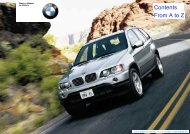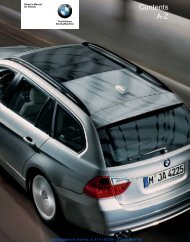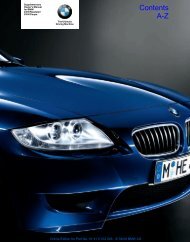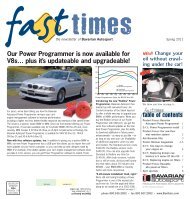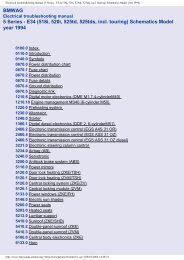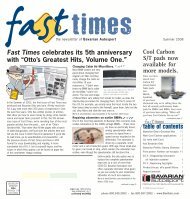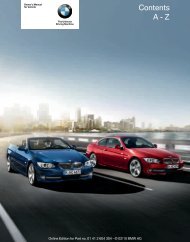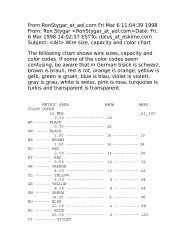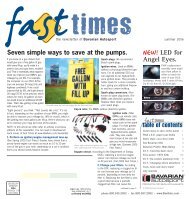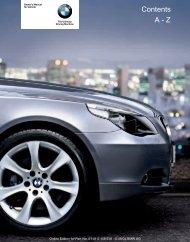Online Edition for Part no. 01 41 2 604 027 - © 03/10 BMW AG
Online Edition for Part no. 01 41 2 604 027 - © 03/10 BMW AG
Online Edition for Part no. 01 41 2 604 027 - © 03/10 BMW AG
You also want an ePaper? Increase the reach of your titles
YUMPU automatically turns print PDFs into web optimized ePapers that Google loves.
Things to remember when driving<br />
planing, and is characterized by a partial or<br />
complete loss of contact between the tires and<br />
the road surface, ultimately undermining your<br />
ability to steer and brake the vehicle.<<br />
The risk of hydroplaning increases as the tread<br />
depth of the tires decreases, also refer to Minimum<br />
tread depth on page 248.<br />
Driving through water<br />
Maximum water depth:<br />
> <strong>BMW</strong> X5 20 in/50 cm<br />
> <strong>BMW</strong> X6 17 in/45 cm<br />
Only drive through water up to the abovementioned<br />
depth at <strong>no</strong> greater than walking<br />
speed; otherwise, the engine, electrical system,<br />
and transmission can be damaged.<<br />
Braking safely<br />
Your <strong>BMW</strong> is equipped with ABS as a standard<br />
feature. In situations that require it, it is best to<br />
brake with full <strong>for</strong>ce. Since the vehicle maintains<br />
steering responsiveness, you can still avoid<br />
possible obstacles with a minimum of steering<br />
ef<strong>for</strong>t.<br />
Pulsation of the brake pedal, combined with<br />
sounds from the hydraulic circuits, indicate that<br />
ABS is in its active mode.<br />
Do <strong>no</strong>t drive with your foot resting on the<br />
brake pedal. Even light but consistent<br />
pedal pressure can lead to high temperatures,<br />
brake wear and possibly even brake failure.<<br />
gear in which the least braking is required. Even<br />
light but consistent pressure on the brake pedal<br />
can lead to high temperatures, brake wear and<br />
possibly even brake failure.<<br />
The braking effect of the engine can be further<br />
increased by downshifting in the manual mode<br />
of the automatic transmission, if necessary into<br />
first gear, refer to page 64. This prevents an<br />
excessive strain on the brakes.<br />
Do <strong>no</strong>t drive in idle or with the engine<br />
stopped, otherwise there will be <strong>no</strong><br />
engine braking action or support of the braking<br />
<strong>for</strong>ce and steering.<br />
Never allow floor mats, carpets or any other<br />
objects to protrude into the area of movement<br />
of the pedals and impair their operation.<<br />
Corrosion on brake rotors<br />
When the vehicle is driven only occasionally,<br />
during extended periods when the vehicle is <strong>no</strong>t<br />
used at all, and in operating conditions where<br />
brake applications are less frequent, there is an<br />
increased tendency <strong>for</strong> corrosion to <strong>for</strong>m on<br />
rotors, while contaminants accumulate on the<br />
brake pads. This occurs because the minimum<br />
pressure which must be exerted by the pads<br />
during brake applications to clean the rotors is<br />
<strong>no</strong>t reached.<br />
Should corrosion <strong>for</strong>m on the brake rotors, the<br />
brakes will tend to respond with a pulsating<br />
effect that even extended application will fail to<br />
cure.<br />
Driving in wet conditions<br />
When roads are wet or there is heavy rain,<br />
briefly exert gentle pressure on the brake pedal<br />
every few miles. Monitor traffic conditions to<br />
ensure that this maneuver does <strong>no</strong>t endanger<br />
other road users. The heat generated in this<br />
process helps dry the pads and rotors to ensure<br />
that full braking efficiency will then be available<br />
when you need it.<br />
Hills<br />
To prevent overheating and the resulting<br />
reduced efficiency of the brake system,<br />
drive long or steep downhill gradients in the<br />
140<br />
When vehicle is parked<br />
Condensation <strong>for</strong>ms in the automatic climate<br />
control system during operation, and then exits<br />
under the vehicle. Traces of condensed water<br />
under the vehicle are there<strong>for</strong>e <strong>no</strong>rmal.<br />
Loading<br />
To avoid loading the tires beyond their<br />
approved carrying capacity, never overload<br />
the vehicle. Overloading can lead to overheating<br />
and increases the rate at which damage<br />
develops inside the tires. The ultimate result<br />
can assume the <strong>for</strong>m of a sudden blowout.



